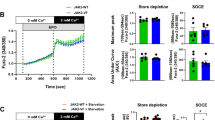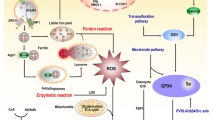Summary
Leukemia seems to depend on a small population of “leukemia stem cells (LSCs)” for its growth and metastasis. However, the precise surviving mechanisms of LSCs remain obscure. Cellular senescence is an important obstacle for production and surviving of tumor cells. In this study we investigated the activated state of a pathway, in which reactive oxygen species (ROS) induces cellular senescence through DNA damage and phophorylation of p38 MAPK (p38), in myeloid leukemic CD34+CD38− cells. Bone marrow samples were obtained from patients with acute myeloid leukemia (AML, n=11) and chronic myeloid leukemia (CML, n=9). CD34+CD38− cells were isolated from mononuclear cells from these bone marrow samples, and K562 and KG1a cells (two kinds of myeloid leukemia cell lines) by mini-magnetic activated cell sorting. Hematopoietic stem cells (HSCs) from human cord blood served as controls. Intracellular ROS level was detected by flow cytometry. DNA damage defined as the γH2AX level was measured by immunofluorescence staining. Real-time RT-PCR was used to detect the expression of p21, a senescence-associated gene. Western blotting and immunofluorescence staining were employed to determine the p38 expression and activation. The proliferation and apoptosis of CD34+CD38− cells were detected by MTT assay and flow cytometry. Our results showed that ROS and DNA damage were substantially accumulated and p38 was less phosphorated in myeloid leukemic CD34+CD38− cells as compared with HSCs and H2O2-induced senescent HSCs. Furthermore, over-phosphorylation of p38 by anisomycin, a selective activator of p38, induced both the senescence-like growth arrest and apoptosis of CD34+CD38− cells from K562 and KG1a cell lines. These findings suggested that, although excessive accumulation of oxidative DNA damage was present in LSCs, the relatively decreased phosphorylation of p38 might help leukemic cells escape senescence and apoptosis.
Similar content being viewed by others
References
Chan WI, Huntly BJ. Leukemia stem cells in acute myeloid leukemia. Semin Oncol, 2008,35(4):326–335
Eppert K, Takenaka K, Lechman ER, et al. Stem cell gene expression programs influence clinical outcome in human leukemia. Nat Med, 2011,17(9):1086–1093
Visconti R, Grieco D. New insights on oxidative stress in cancer. Curr Opin Drug Discov Devel, 2009,12(2): 240–245
Naka K, Muraguchi T, Hoshii T, et al. Regulation of reactive oxygen species and genomic stability in hematopoietic stem cells. Antioxid Redox Signal, 2008,10(11):1883–1894
Wang Y, Schulte BA, LaRue AC, et al. Total body irradiation selectively induces murine hematopoietic stem cell senescence. Blood, 2006,107(1):358–366
Collado M, Serrano M. Senescence in tumours: evidence from mice and humans. Nat Rev Cancer, 2010,10(1): 51–57
Collado M, Gil J, Efeyan A, et al. Tumour biology: senescence in premalignant tumours. Nature, 2005,436(7051):642
Sallmyr A, Fan J, Datta K, et al. Internal tandem duplication of FLT3 (FLT3/ITD) induces increased ROS production, DNA damage, and misrepair: implications for poor prognosis in AML. Blood, 2008,111(6):3173–3182
Sattler M, Verma S, Shrikhande G, et al. The BCR/ABL tyrosine kinase induces production of reactive oxygen species in hematopoietic cells. J Biol Chem, 2000, 275(32):24273–24278
Koptyra M, Falinski R, Nowicki MO, et al. BCR/ABL kinase induces self-mutagenesis via reactive oxygen species to encode imatinib resistance. Blood, 2006,108(1): 319–327
Rassool FV, Gaymes TJ, Omidvar N, et al. Reactive oxygen species, DNA damage, and error-prone repair: a model for genomic instability with progression in myeloid leukemia? Cancer Res, 2007,67(18):8762–8771
Ito K, Hirao A, Arai F, et al. Reactive oxygen species act through p38 MAPK to limit the lifespan of hematopoietic stem cells. Nat Med, 2006,12(4):446–451
Wang Y, Liu L, Pazhanisamy SK, et al. Total body irradiation causes residual bone marrow injury by induction of persistent oxidative stress in murine hematopoietic stem cells. Free Radic Biol Med, 2010,48(2):348–356
Wang Y, Kellner J, Liu L, et al. Inhibition of p38 mitogen-activated protein kinase promotes ex vivo hematopoietic stem cell expansion. Stem Cells Dev, 2011,20(7):1143–1152
Zou J, Zou P, Lou Y, et al. The cross-talk between ROS and p38MAPKalpha in the ex vivo expanded human umbilical cord blood CD133(+) cells. J Huazhong Univ Sci Technolog Med Sci, 2011,31(5):591–595
Dolado I, Swat A, Ajenjo N, et al. p38alpha MAP kinase as a sensor of reactive oxygen species in tumorigenesis. Cancer Cell, 2007,11(2):191–205
Ambrosino C, Nebreda AR. Cell cycle regulation by p38 MAP kinases. Biol Cell, 2001,93(1–2):47–51
Zhou L, Opalinska J, Verma A. p38 MAP kinase regulates stem cell apoptosis in human hematopoietic failure. Cell Cycle, 2007,6(5):534–537
Haq R, Brenton JD, Takahashi M, et al. Constitutive p38HOG mitogen-activated protein kinase activation induces permanent cell cycle arrest and senescence. Cancer Res, 2002,62(17):5076–5082
Bulavin DV, Fornace AJ. p38 MAP kinase’s emerging role as a tumor suppressor. Adv Cancer Res, 2004, 92:95–118
Author information
Authors and Affiliations
Corresponding authors
Additional information
The project was supported by a grant from Central University Basic Scientific Research Foundation of China (No. 2010JC026).
Rights and permissions
About this article
Cite this article
Xiao, Y., Zou, P., Wang, J. et al. Lower phosphorylation of p38 MAPK blocks the oxidative stress-induced senescence in myeloid leukemic CD34+CD38− cells. J. Huazhong Univ. Sci. Technol. [Med. Sci.] 32, 328–333 (2012). https://doi.org/10.1007/s11596-012-0057-z
Received:
Published:
Issue Date:
DOI: https://doi.org/10.1007/s11596-012-0057-z




